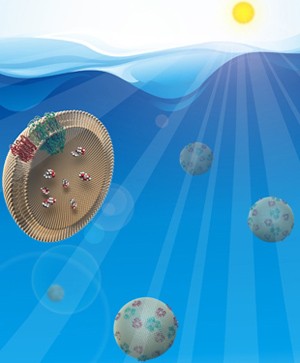
Research Harnesses Solar-Powered Proteins to Filter Harmful Antibiotics from Water
New research, just published, details how University of Cincinnati researchers have developed and tested a solar-powered nano filter that is able to remove harmful carcinogens and antibiotics from water sources lakes and rivers at a significantly higher rate than the currently used filtering technology made of activated carbon.
In the journal Nano Letters, Vikram Kapoor, environmental engineering doctoral student, and David Wendell, assistant professor of environmental engineering, report on their development and testing of the new filter made of two bacterial proteins
that was able to absorb 64 percent of antibiotics in surface waters vs. about 40 percent absorbed by the currently used filtering technology
made of activated carbon. One of the more exciting aspects of their filter is the ability to reuse the antibiotics that are captured.
Kapoor and Wendell began development of their new nano filter in 2010 and testing in 2012, with the results reported in a paper titled
Engineering Bacterial Efflux Pumps for Solar-Powered Bioremediation of Surface Waters.
The presence of antibiotics in surface waters is harmful in that it breeds resistant bacteria and kills helpful microorganisms, which can degrade aquatic environments and food chains. In other words, infectious agents like viruses and illness-causing bacteria become more numerous while the health of streams and lakes degrades.
So, according to Wendell, the newly developed nano filters, each much smaller in diameter than a human hair, could potentially have a big impact on both human health and on the health of the aquatic environment (since the presence of antibiotics in surface waters can also affect the endocrine systems of fish, birds and other wildlife).
Surprisingly, this filter employs one of the very elements that enable drug-resistant bacteria to be so harmful, a protein pump called AcrB. Wendell explained, These pumps are an amazing product of evolution. They are essentially selective garbage disposals for the bacteria. Our innovation was turning the disposal system around. So, instead of pumping out, we pump the compounds into the proteovesicles." (The new filtering technology is called a proteovesicle system.)
One other important innovation was the power source, a light-driven bacterial protein called Delta-rhodopsin which supplies AcrB with the pumping power to move the antibiotics.
The bacterial protein system has a number of advantages over present filtration technology:
- The operation of the new filtering technology is powered by direct sunlight vs. the energy-intensive needs for the operation of the standard activated carbon filter.
- The filtering technology also allows for antibiotic recycling. After these new nano filters have absorbed antibiotics from surface waters, the filters could be extracted from the water and processed to release the drugs, allowing them to be reused. On the other hand, carbon filters are regenerated by heating to several hundred degrees, which burns off the antibiotics.
- The new protein filters are highly selective. Currently used activated carbon filters serve as catch alls, filtering a wide variety of contaminants. That means that they become clogged more quickly with natural organic matter found in rivers and lakes.
Said Wendell, So far, our innovation promises to be an environmentally friendly means for extracting antibiotics from the surface waters that we all rely on. It also has potential to provide for cost-effective antibiotic recovery and reuse. Next, we want to test our system for selectively filtering out hormones and heavy metals from surface waters.
In relation to the work published in this paper, Wendell and Kapoor tested their solar-powered nano filter against activated carbon, the present treatment technology standard outside the lab. They tested their innovation in water collected from the Little Miami River. Using only sunlight as the power source, they were able to selectively remove the antibiotics ampicillin and vancomycin, commonly used human and veterinary antibiotics, and the nucleic acid stain, ethidium bromide, which is a potent carcinogen to humans and aquatic animals.
- Read more on research by UCs David Wendell: Frogs, Foam and Fuel: UC Researchers Convert Solar Energy to Sugars
- Apply to UCs doctoral program in environmental engineering.
Related Stories
UC education allowed couple to make mark on Cincinnati
April 24, 2024
As a native of Defiance, Ohio, John Deatrick, CEAS ’79, says arriving in Cincinnati to attend the University of Cincinnati in 1963 felt like landing in New York City.
Engineering student studying flight physics of birds
April 24, 2024
After earning a bachelor's degree in mechanical engineering in Nepal, Sameer Pokhrel came to the United States to further his education. From an early age, he had a lifelong fascination with aviation. As an adult, he transformed this fascination into a career, pursuing a doctoral degree in aerospace engineering at the University of Cincinnati's historic program. Here, he has succeeded in research, instruction, and was recently named Graduate Student Engineer of the Month by the College of Engineering and Applied Science.
Engineering students present at third annual Expo
April 24, 2024
This spring, senior students at the University of Cincinnati's College of Engineering and Applied Science came together to present their final capstone projects at the third annual CEAS Expo. College faculty, staff, alumni and industry professionals attended the event to witness the innovation that is created at CEAS.
